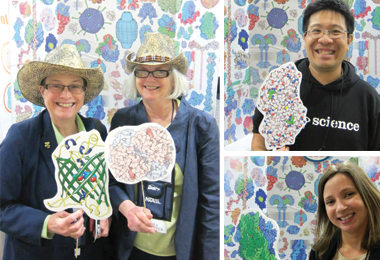Education Corner
PDB-101 and the 2013 Meeting of the National Science Teachers Association
Science educators from around the world come together at annual meetings of the National Science Teachers Association (NSTA; nsta.org). Approximately 8,500 people attended this year's conference, held April 11-13 in San Antonio, Texas.
Through a workshop and exhibition booth, the RCSB PDB met with users (new and old) and demonstrated PDB-101 features and downloadable activities.
A new feature of the RCSB PDB stand was a "photo booth" that drew in many visitors. Attendees were asked to pose with their "favorite" molecule against a backdrop image of hundreds of Molecule of the Month images. Teachers were then asked to select their favorite molecule from among the most popular Molecule of the Month features. Their pictures and choices were posted to the RCSB PDB's Facebook page. When the results were tallied, Green Fluorescent Protein was shown to be the NSTA's favorite.


Teachers posed with their favorite molecule in the RCSB–PDB's exhibit booth. All photos are posted at www.facebook.com/RCSBPDB.
Molecule of the Month author David Goodsell presented a workshop on Exploring Proteins and Nucleic Acids at the PDB. He described all aspects of the structure determination pipeline, how to access PDB structures from the RCSB PDB website, and highlighted the PDB-101 resources described here.Protein and nucleic acid structure was a topic throughout the NSTA meeting, as seen in other presentations, workshops, and exhibit booths, including:
- The WestEd workshop Tangible Models and Augmented Reality: New Technology for High School Biology Classrooms let teachers build physical 3D models of DNA and a virus structure. These physical models are linked with iPad programs that enhance the overall lesson (www.wested.org).
- Science Take-Out presented a simple hands-on exercise that modeled how coded information in genes results in proteins with specific shapes that perform specific functions (sciencetakeout.com).
- 3D Molecular Designs/MSOE Center for BioMolecular Modeling offers kits to build physical models, such as the Insulin mRNA to Protein and DNA Starter Kits, and opportunities for professional development to educators (www.3dmoleculardesigns.com).
PDB-101 Resources
Throughout the NSTA meeting, attendees were presented with information and discussions about the PDB-101 website. Designed for teachers, students, and the general public, PDB-101 promotes exploration of the world of proteins and nucleic acids by packaging together educational resources and materials, including posters, animations, and classroom lessons and activities.
Posters/Exhibits
The flyer What is a Protein? introduces protein structure and function to beginners.
Structures of the Citric Acid Cycle illustrates the PDB structures involved in this important metabolic pathway.-
3D Paper Models
DNA resources have been translated into Spanish, including the Molecule of the Month article and the paper model template.
-
Molecule of the Month
Articles describe the structure and function of a molecule, offer interactive views and discussion topics, and link to specialized pages to help explore specific example structures.
July's Molecule of the Month highlights the structure of the HIV capsid, and includes a downloadable PDF that can be folded into a 3D paper model. Structural View of Biology
Built around the Molecule of the Month series, this browser promotes a top-down exploration of the PDB. Readers can travel through high-level functional categories (such as Protein Synthesis and Health and Disease) and descriptive subcategories (like Replication or Immune System) to access relevant articles that describe molecules in simple terms and provide specific examples.Understanding PDB Data
Understanding PDB Data is a reference guide for exploring and interpreting individual PDB entries. Broad topics include how to understand PDB data, how to visualize structures, how to read coordinate files, and potential challenges to exploring the archive.Author Profiles
Author Profiles offer historical and educational timelines of the structures associated with a particular researcher. Example profiles and searches for authors and structural genomics centers are available.




